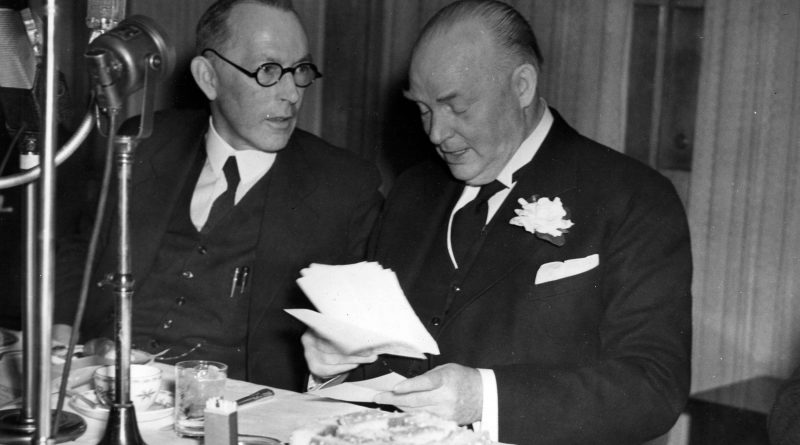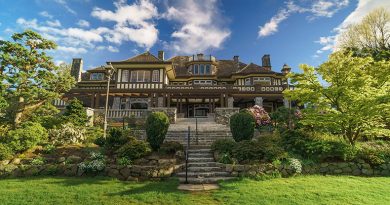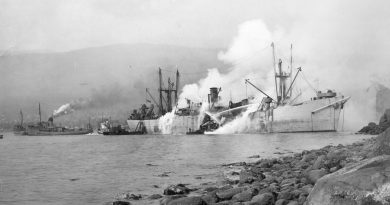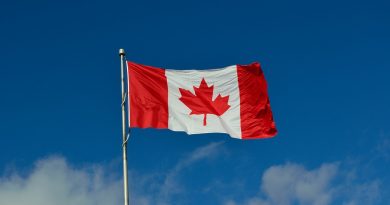1934
Above: R.B. Bennett with chairman Jim McVety at luncheon, circa 1939.
[Image: Vancouver City Archives AM1616-S1-: CVA 136-357
*****************************************
You’ll note that these years include events listed under “Also in . . .” These are events for which we don’t have a specific date. If YOU know the specific date of an event shown there, please notify us . . . and cite the source! Many thanks!
*****************************************
January 1 There was a riot in Chinatown as “more than 1,000 Orientals and white men” battled savagely in the unit and 100 blocks East Pender. Police reserves fought for more than an hour to disperse the mobs before the Fire Department was called to assist with high-pressure hoses. Cause of the riot was apparently an altercation between a Chinese taxi driver and his Occidental passenger. The Chinese allegedly struck the white man on the head with a hammer.
January 5 The Vancouver Library Board accepted city council help to reopen the Library’s reading room, closed for most of 1933 from lack of funds.
January 16 As they had done the year before, the Sun announced that today’s paper would be edited by the staff of the Ubyssey, the student newspaper at UBC. Staff members of the latter cited: Archie Thompson, John Cornish, Pat Kerr, Boyd Agnew, Nancy Miles, Norman Hacking (editor-in-chief of the Ubyssey), Alan Morley, Jack Paul, Darrel Gomery, Zoe Browne-Clayton and Dick Elson. Alan Morley’s name leaps out: he will write the first (and still, in some ways, the best) Vancouver history: Vancouver: From Milltown to Metropolis 1961.
January 19 Prime Minister R.B. Bennett spoke to the Vancouver Board of Trade’s 47th anniversary dinner at the Hotel Vancouver. Among his words, “Canada is a world example of successful weathering of this depression.” Yeah, right.
January Almost four thousand passengers were ferried from the city to the Ambleside ferry dock on a single day in January, 1934. Their destination: the trailhead on Hollyburn Mountain, popular with skiers and hikers.
February 1 The Vienna Choir Boys performed in Vancouver. They will appear again in 1935 presented by New York impresario Sol Hurok.
March 6 Future provincial politician Graham Lea was born.
March 24 “Jack” Drainie (more well known later as John) appeared in a play produced by the Vancouver Little Theatre Assn. It’s Anderson’s Elizabeth the Queen. J.V. Clyne played Sir Walter Raleigh.
April 26 Carol Burnett was born.
May 1 Alphonse E. Savard, photographer, born in 1864 in Quebec City, died in Vancouver, aged about 70. He trained as a photographer in Quebec City. A commercial portrait photographer, his studio (Imperial Photo Studio) prospered in Vancouver from 1896 to 1916. He later worked at Britannia Mines.
May 13 Acting Premier A. Wells Gray cut the ribbon on a 25-bed children’s hospital, opened in 1933 at 250 West 59th Avenue. The official opening ceremony had been delayed for months by a scarlet fever outbreak.
May 21 The first sod for the construction of Malkin Bowl in Stanley Park was turned by former mayor and wholesale food merchant William H. Malkin. The bowl was a gift to the city from Malkin as a memorial to his late wife Marion, who had died in 1933. Its formal name is the Marion Malkin Bowl. “It replaced an old circular bandstand which stood on the very same spot,” Malkin recalled in a 1952 interview. “So many people were wondering why we had a village-style bandstand in a beautiful, big-city park that I decided something must be done about it.” The “something” was a donation of $8,000, plenty of money in those Depression days. The shell of the structure is patterned after the famous Hollywood Bowl. The original stage was 16.5 metres (54 feet) wide.
May 28 The Dionne quintuplets were born in Callender, Ontario.
May 29 Future B.C. premier Bill Vander Zalm (1986-91) was born in Noordwykerhout, the Netherlands. His family came to Canada in 1947. His full birth name was Wilhelmus Nicholaas Theodore Marie Vander Zalm.
May Vancouver boxer Jimmy McLarnin, who had won the world welterweight championship May 29, 1933, kayoing Young Corbett, lost it to Barney Ross. He regained it in September, lost it again in May, 1935.
June 15 Singer Arnie Nelson was born. He was a child star on CKNW.
June The Fraser Valley Union Library District—the first regional library in North America—was established with headquarters in Abbotsford. The per capita tax rate to finance the system was set at 35 cents annually. The financial hardship for the young system was offset by an agreement among the participating communities to provide rent-free space. (In 1950 the rate was raised to 40 cents.)
July 1 The first United Airlines flight arrived at the Vancouver Airport. The move brought Vancouver air links with most of the continent and introduced the first modern airliner, the all-metal Boeing 247, capable of speeds up to 180 miles an hour. “Airports need airlines to succeed,” writer Sean Rossiter noted in The Greater Vancouver Book, “and, as well-planned and located as Vancouver Airport was, it had no airlines for the first three years of its opulent, if isolated, existence. It became jokingly known as ‘Templeton’s Farm.’ . . . It was manager William Templeton who is said to have exercised some kind of inside influence in persuading Sewell Hall, United Airlines’ Seattle superintendent, to give Vancouver a try.”
July 5 Frank (Francis) E. Harrison, former postmaster, died in Vancouver. He was born February 1, 1861 in Stratford, Ontario. In 1889 he came to B.C. and opened the Mainland’s first RMS (Railway Mail Service) office. When the Vancouver Post Office was placed on a city basis in 1895 he was assistant postmaster under Jonathan Miller. He succeeded R.G. Macpherson as postmaster January 10, 1920 and retired in 1928.
July 8 The first performance of the Vancouver Symphony Orchestra was held in Malkin Bowl. The performance was to celebrate the official opening of the bowl. In later years Theatre Under The Stars (TUTS) would make the Bowl its home. A group called the Home Gas Orchestra played often there.
July 13 Coquitlam councillor Thomas Douglas was shot dead at his North Road gas station. Because he was a socialist—he had run provincially for the United Front, a Socialist party—some thought the murder had political overtones.
September 28 Journalist Trevor Lautens was born.
September First radio broadcasts of local lacrosse games.
November 17 R.H. Pooley, a Conservative MLA, made the Province’s front page with a charge that “professors at the University of British Columbia are teaching communism to our boys and girls . . . Those same professors are flourishing under the capitalist system. They are paid high salaries, but ask them to take a 10 per cent cut and they are the first to kick.” UBC president Leonard Klinck said he didn’t take Pooley very seriously. “Communism is dealt with, but it is never taught in the sense that Mr. Pooley means. After all, we can recognize the existence of a thing without preaching it.”
November A newly reconstructed Second Narrows bridge opened. “The span over the real ships’ channel,” engineering historian Robert Harris wrote, “was rebuilt as a 85.3-metre lift span, hoisted between two new steel towers. The new design was more successful; though often hit by shipping, it was never closed for more than 10 days. ‘Progress’ called for an improved crossing. This was done in two stages: on the west side by a high-level road bridge and by a medium-level rail bridge on the east side. The old bridge could not compete with the convenience of the new; it was closed to highway traffic in 1963, and sold to the CNR for $1.” A brief, nicely-illustrated history of the bridge can be seen at this site.
December 8 Negotiations were under way for a “central heating plant” for the downtown district and West End to be placed at “the north end of the Cambie Street bridge.” We assumed that referred to today’s Central Heat Distribution, at 720 Beatty, with a heating plant serving the downtown. But no, CHD didn’t start until 1966, and knew nothing of this earlier scheme! The chief sponsor of the 1934 project, H.A. Flood, told council “that progress is rapidly being made on the scheme, and he expects to announce soon when work will be started.”
December 13 Gerald Grattan “Gerry” McGeer, 46, was swept into the mayoralty with the largest lead in Vancouver history: 25,000 votes out of 44,000 cast. He defeated L.D. Taylor, the most elected mayor in the city’s history. The McGeer victory put an end to Taylor’s political career.
Also in 1934
A 20-year-old fellow named Foncie Pulice (the family pronounces it like the word “police”) set up a camera on the sidewalk on Granville Street in downtown Vancouver and began taking pictures of passersby. Pulice wasn’t the only one doing this at the time. Sidewalk photographers were taking candid shots of individuals, couples and family and other groups walking by in many major Canadian cities. They’d hand them a numbered ticket with an invitation to drop by their shop later to buy a copy of the picture. What would make Pulice absolutely unique in this trade is the length of time he kept at it: 45 years. And for the last 33 years of his career he used the same camera: his Electric-Photo camera—now preserved at the Vancouver Museum—was as familiar a local landmark as the Marine Building.
He took pictures on Granville Street, at the Pacific National Exhibition, in Stanley Park, elsewhere . . . millions of pictures. It’s possible that Foncie Pulice photographed more people than anybody else in the world.
“When I started back in 1934,” Foncie recalled in a Nov. 21, 1979 interview in the Province, “there were six companies in Vancouver, but when we really started to go was during the war. The public couldn’t get film, you see, so the street photographers were all they had. Servicemen would come home on leave, they’d have pictures taken. Families would get together, we’d take their picture. At one time, I was taking 4,000 to 5,000 pictures every day.”
The PNE gave away a home as part of the first Prize Home Lottery. This was the first time such a significant prize had ever been awarded. The prize was valued at more than $5,000 including home, east Vancouver lot and furnishings (from Eaton’s).
Francis William Caulfeild died in London, England, aged 94. In 1899 he had bought the land between Cypress Creek and Point Atkinson—an area called Skunk Cove. He renamed it Caulfeild and began to lay out a village. Shunning the North American grid where straight streets and avenues intersect at right angles, he laid out a village of the English type with winding lanes following the natural contours of the wooded slopes. (A curiosity: he never lived in B.C., although he visited often, making his last trip in 1926.)
Howard Rodgers operated a water taxi and rescue boat from Horseshoe Bay, running mercy missions for the Britannia Mines.
Amsterdam-born Dorothy Gretchen Steeves, 39, one of the founders of the CCF, was elected as MLA for North Vancouver, one of seven original CCF members in B.C. She would hold the seat for 11 years.
Convicts in the B.C. Penitentiary refused to work unless given wages, then went on a rampage destroying prison property. It was the first disturbance of any note at the prison. It would not be the last.
Minnekhada Lodge in Coquitlam was built as a country retreat and hunting lodge by Eric W. Hamber, later Lt.-Gov. of B.C. Architectural historian Dr. Harold Kalman has written: “Begun around 1910 as a productive farm, and expanded in the 1930s to become a country retreat and hunting lodge, this social and architectural anachronism was conceived on the model of an English stately home, albeit rusticated by the realities of British Columbia. The Tudor Revival hunting lodge was built by lumber magnates Eric Hamber and Aldyen Irene (née Hendry) Hamber, who retained the Sioux name given to the farm a generation earlier by lumberman Harry Jenkins. Minnekhada has been home to two Lieutenant-Governors: Eric Hamber (1936-41) and shipbuilder Colonel Clarence Wallace (1950-55). The estate has hosted royalty and boasts a royal suite, and Governor-General Lord Tweedsmuir and his sons played polo here. The area around the house commands fine views of the Pitt River and retains a Japanese garden. Minnekhada is now the people’s palace, situated within a regional park that boasts good trails and birdwatching opportunities.” Minnekhada is now managed by GVRD Parks. (The word is a Sioux Indian name meaning “water rattling by”.)
A long row of horse chestnut trees was planted on 17th Street in West Vancouver by Boy Scouts to commemorate the visit from England of Scout leader Lord Baden-Powell.
Berta Marega, sculptor Charles Marega’s wife, died. “From that time,” researcher Peggy Imredy wrote, “regardless of his commissions and work, life appeared drained from him.”
The Jewish Congress was founded in Vancouver.
The Kiwassa Club of Vancouver was formed by 100 wives of members of the Kiwanis Club of Vancouver.
St. Peter’s Cathedral on Blackwood Street in New Westminster, built in 1886, was battered beyond repair by a powerful storm. A new church was planned.
Deaf and blind Charlie Crane enrolled as a special student at UBC. He proved outstanding in athletics, particularly in wrestling.
Radio station CRCV appeared, headquartered on Station Street off Main. It had been CNRV, the CNR station, but now it was run by a new entity called the Canadian Radio Commission, which in 1936 would change yet again to the CBC, the Canadian Broadcasting Corporation.
South Italy-born Joe Philliponi (born Filippone), 21, future nightclub owner, who had come to Vancouver in the early 1930s, started Eagle-Time Delivery Systems.
A monthly periodical, Garage & Service Station News, first appeared.
Fraserview Golf Course opened.
Bobby Jones, considered along with Jack Nicklaus one of the century’s best golf players, visited Vancouver and played at Shaughnessy Heights Golf Club.
Victoria-born Lynn Patrick, 22, whose name is mostly associated with hockey, signed with football’s Winnipeg Blue Bombers this year. In the first game, he set a season record for the team with a 68-yard touchdown reception.
Jack Short, 25, began his astonishing run of broadcasting race results over CJOR. (He had started in 1933 on another station.) “Too tall and too lanky” to succeed as a jockey, he called nearly 50,000 races at Exhibition Park, broadcast live for CJOR radio. He invariably signed off his broadcasts with the famous catch phrase, “Adiós amigos!” Jack wrapped it up in 1976.
June Roper, a teacher from Rosebud, Texas, settled in Vancouver after a distinguished career as a dancer in Europe. She will become an extraordinarily influential dancing teacher here.
Peter Stursberg began his journalism career at the Victoria Daily Times.
Perth, Australia-born Dorothy Somerset, who had moved to Vancouver in 1921, began as a director with the University Players’ Club. She would be a prominent theatre figure here for more than 50 years.
Manitoba-born Ira Dilworth, scholar and broadcaster, became a popular associate professor of English at UBC. Later, he will become an influential CBC figure.
Buckinghamshire, England-born Charles Edward Findlater, who had come to Vancouver in 1918 to teach voice and piano, founded the Elgar Choir.
Jessie Columbia Hall received Vancouver’s Good Citizen Award. Her long career of volunteerism included working with the Children’s Aid Society, Vancouver Welfare Federation, Women’s Auxiliary of Christ Church and others. During WWI, she provided supplies for a French field hospital. She was the first woman to serve as a member of a Vancouver jury. President, Burrard Women’s Conservative Club (1931) and Victorian Order of Nurses.
Helen Gregory MacGill, the first woman to be a judge in this province, was named to the B.C. board of industrial relations.
Dresden, Ontario-born Mildred Valley Thornton, artist and art critic, arrived in Vancouver from Saskatchewan. She will be a force on the local art scene for 25 years.
Lily Alice Lefevre, poet and philanthropist, presented a $5,000 scholarship and gold medal to UBC in memory of her husband, Dr. John Matthew Lefevre (1853-1906). They had come to Vancouver in 1886, when Dr. Lefevre became surgeon general for the CPR’s Pacific Division.
Joseph Moore Steves, the second son of William Herbert Steves, who founded Steveston, died. Joseph Steves developed B.C.’s largest Holstein herd, supplying milk for Vancouver until the cattle were sold during the Depression.
A local poet named Alexander Maitland Stephen wrote the poem Vancouver this year. It was widely anthologized. Here is an excerpt:
Vancouver
Who can snare the soul of a city
in a butterfly net of words?
Who can melt steel and concrete
into the flowing matrix of song?
Yet there is a word-symbol,
if it can be found,
There is a sign and a password
in the plastic stuff of mind,
an image behind the veil,
that can reveal the meaning of a city.
Nineveh, Babylon, Rome —
the sound of them is an echo in an empty room,
stirring the dust of dead men’s bones.
Vancouver —
the sound of it is a wave,
breaking on the shores of the future.
Tune in . . .




